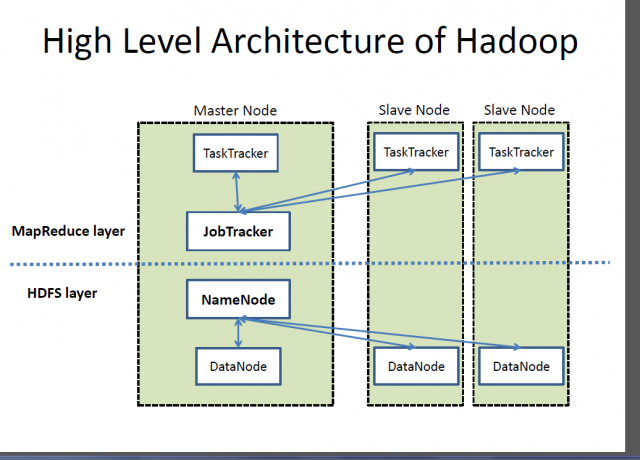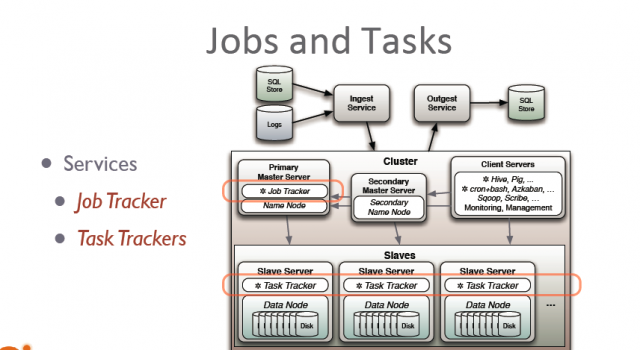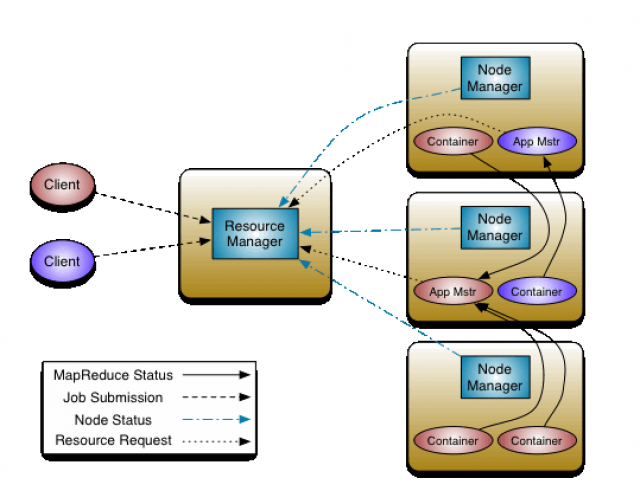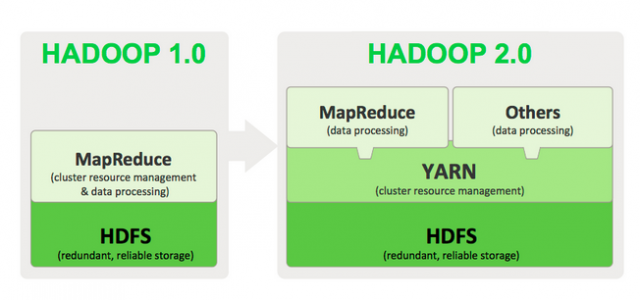Apache Hadoop is an open source software framework for storage and large
scale processing of data-sets on clusters of commodity hardware. Hadoop
is an Apache top-level project being built and used by a global
community of contributors and users. It is licensed under the Apache
License 2.0.
Hadoop was created by Doug Cutting and Mike Cafarella in 2005. It was originally developed to support distribution for the Nutch search engine project. Doug, who was working at Yahoo! at the time and is now Chief Architect of Cloudera,
named the project after his son's toy elephant. Cutting's son was 2
years old at the time and just beginning to talk. He called his beloved
stuffed yellow elephant "Hadoop" (with the stress on the first
syllable). Now 12, Doug's son often exclaims, "Why don't you say my
name, and why don't I get royalties? I deserve to be famous for this!"
The Apache Hadoop framework is composed of the following modules
- Hadoop Common: contains libraries and utilities needed by other Hadoop modules
- Hadoop Distributed File System (HDFS): a distributed file-system that stores data on the commodity machines, providing very high aggregate bandwidth across the cluster
- Hadoop YARN: a resource-management platform responsible for managing compute resources in clusters and using them for scheduling of users' applications
- Hadoop MapReduce: a programming model for large scale data processing
All the modules in Hadoop are designed with a fundamental assumption
that hardware failures (of individual machines, or racks of machines)
are common and thus should be automatically handled in software by the
framework. Apache Hadoop's MapReduce and HDFS components originally
derived respectively from Google's MapReduce and Google File System
(GFS) papers.
Beyond HDFS, YARN and MapReduce, the entire Apache Hadoop "platform"
is now commonly considered to consist of a number of related projects as
well: Apache Pig, Apache Hive, Apache HBase, and others.

For the end-users, though MapReduce Java code is common, any
programming language can be used with "Hadoop Streaming" to implement
the "map" and "reduce" parts of the user's program. Apache Pig and
Apache Hive, among other related projects, expose higher level user
interfaces like Pig latin and a SQL variant respectively. The Hadoop
framework itself is mostly written in the Java programming language,
with some native code in C and command line utilities written as
shell-scripts.
HDFS and MapReduce
There are two primary components at the core of Apache Hadoop 1.x:
the Hadoop Distributed File System (HDFS) and the MapReduce parallel
processing framework. These are both open source projects, inspired by
technologies created inside Google.

Hadoop distributed file system
The Hadoop distributed file system (HDFS) is a distributed, scalable,
and portable file-system written in Java for the Hadoop framework. Each
node in a Hadoop instance typically has a single namenode, and a
cluster of datanodes form the HDFS cluster. The situation is typical
because each node does not require a datanode to be present. Each
datanode serves up blocks of data over the network using a block
protocol specific to HDFS. The file system uses the TCP/IP layer for
communication. Clients use Remote procedure call (RPC) to communicate
between each other.

HDFS stores large files (typically in the range of gigabytes to
terabytes) across multiple machines. It achieves reliability by
replicating the data across multiple hosts, and hence does not require
RAID storage on hosts. With the default replication value, 3, data is
stored on three nodes: two on the same rack, and one on a different
rack. Data nodes can talk to each other to rebalance data, to move
copies around, and to keep the replication of data high. HDFS is not
fully POSIX-compliant, because the requirements for a POSIX file-system
differ from the target goals for a Hadoop application. The tradeoff of
not having a fully POSIX-compliant file-system is increased performance
for data throughput and support for non-POSIX operations such as Append.
HDFS added the high-availability capabilities for release 2.x,
allowing the main metadata server (the NameNode) to be failed over
manually to a backup in the event of failure, automatic fail-over.
The HDFS file system includes a so-called secondary namenode, which
misleads some people into thinking that when the primary namenode goes
offline, the secondary namenode takes over. In fact, the secondary
namenode regularly connects with the primary namenode and builds
snapshots of the primary namenode's directory information, which the
system then saves to local or remote directories. These checkpointed
images can be used to restart a failed primary namenode without having
to replay the entire journal of file-system actions, then to edit the
log to create an up-to-date directory structure. Because the namenode is
the single point for storage and management of metadata, it can become a
bottleneck for supporting a huge number of files, especially a large
number of small files. HDFS Federation, a new addition, aims to tackle
this problem to a certain extent by allowing multiple name-spaces served
by separate namenodes.
An advantage of using HDFS is data awareness between the job tracker
and task tracker. The job tracker schedules map or reduce jobs to task
trackers with an awareness of the data location. For example, if node A
contains data (x, y, z) and node B contains data (a, b, c), the job
tracker schedules node B to perform map or reduce tasks on (a,b,c) and
node A would be scheduled to perform map or reduce tasks on (x,y,z).
This reduces the amount of traffic that goes over the network and
prevents unnecessary data transfer. When Hadoop is used with other file
systems, this advantage is not always available. This can have a
significant impact on job-completion times, which has been demonstrated
when running data-intensive jobs. HDFS was designed for mostly immutable
files and may not be suitable for systems requiring concurrent
write-operations.
Another limitation of HDFS is that it cannot be mounted directly by
an existing operating system. Getting data into and out of the HDFS file
system, an action that often needs to be performed before and after
executing a job, can be inconvenient. A filesystem in Userspace (FUSE)
virtual file system has been developed to address this problem, at least
for Linux and some other Unix systems.
File access can be achieved through the native Java API, the Thrift
API, to generate a client in the language of the users' choosing (C++,
Java, Python, PHP, Ruby, Erlang, Perl, Haskell, C#, Cocoa, Smalltalk, or
OCaml), the command-line interface, or browsed through the HDFS-UI web
app over HTTP.
JobTracker and TaskTracker: The MapReduce engine

Above the file systems comes the MapReduce engine, which consists of
one JobTracker, to which client applications submit MapReduce jobs. The
JobTracker pushes work out to available TaskTracker nodes in the
cluster, striving to keep the work as close to the data as possible.
With a rack-aware file system, the JobTracker knows which node
contains the data, and which other machines are nearby. If the work
cannot be hosted on the actual node where the data resides, priority is
given to nodes in the same rack. This reduces network traffic on the
main backbone network.
If a TaskTracker fails or times out, that part of the job is
rescheduled. The TaskTracker on each node spawns off a separate Java
Virtual Machine process to prevent the TaskTracker itself from failing
if the running job crashes the JVM. A heartbeat is sent from the
TaskTracker to the JobTracker every few minutes to check its status. The
Job Tracker and TaskTracker status and information is exposed by Jetty
and can be viewed from a web browser.
If the JobTracker failed on Hadoop 0.20 or earlier, all ongoing work
was lost. Hadoop version 0.21 added some checkpointing to this process.
The JobTracker records what it is up to in the file system. When a
JobTracker starts up, it looks for any such data, so that it can restart
work from where it left off.
Known limitations of this approach in Hadoop 1.x
The allocation of work to TaskTrackers is very simple. Every
TaskTracker has a number of available slots (such as "4 slots"). Every
active map or reduce task takes up one slot. The Job Tracker allocates
work to the tracker nearest to the data with an available slot. There is
no consideration of the current system load of the allocated machine,
and hence its actual availability. If one TaskTracker is very slow, it
can delay the entire MapReduce job—especially towards the end of a job,
where everything can end up waiting for the slowest task. With
speculative execution enabled, however, a single task can be executed on
multiple slave nodes.
Apache Hadoop NextGen MapReduce (YARN)
MapReduce has undergone a complete overhaul in hadoop-0.23 and we now have, what we call, MapReduce 2.0 (MRv2) or YARN.
Apache™ Hadoop® YARN is a sub-project of Hadoop at the Apache
Software Foundation introduced in Hadoop 2.0 that separates the resource
management and processing components. YARN was born of a need to enable
a broader array of interaction patterns for data stored in HDFS beyond
MapReduce. The YARN-based architecture of Hadoop 2.0 provides a more
general processing platform that is not constrained to MapReduce.

The fundamental idea of MRv2 is to split up the two major
functionalities of the JobTracker, resource management and job
scheduling/monitoring, into separate daemons. The idea is to have a
global ResourceManager (RM) and per-application ApplicationMaster (AM).
An application is either a single job in the classical sense of
Map-Reduce jobs or a DAG of jobs.
The ResourceManager and per-node slave, the NodeManager (NM), form
the data-computation framework. The ResourceManager is the ultimate
authority that arbitrates resources among all the applications in the
system.
The per-application ApplicationMaster is, in effect, a framework
specific library and is tasked with negotiating resources from the
ResourceManager and working with the NodeManager(s) to execute and
monitor the tasks.

As part of Hadoop 2.0, YARN takes the resource management
capabilities that were in MapReduce and packages them so they can be
used by new engines. This also streamlines MapReduce to do what it does
best, process data. With YARN, you can now run multiple applications in
Hadoop, all sharing a common resource management. Many organizations are
already building applications on YARN in order to bring them IN to
Hadoop.

As part of Hadoop 2.0, YARN takes the resource management
capabilities that were in MapReduce and packages them so they can be
used by new engines. This also streamlines MapReduce to do what it does
best, process data. With YARN, you can now run multiple applications in
Hadoop, all sharing a common resource management. Many organizations are
already building applications on YARN in order to bring them IN to
Hadoop. When enterprise data is made available in HDFS, it is important
to have multiple ways to process that data. With Hadoop 2.0 and YARN
organizations can use Hadoop for streaming, interactive and a world of
other Hadoop based applications.
What YARN does
YARN enhances the power of a Hadoop compute cluster in the following ways:
- Scalability: The processing power in data centers continues to grow quickly. Because YARN ResourceManager focuses exclusively on scheduling, it can manage those larger clusters much more easily.
- Compatibility with MapReduce: Existing MapReduce applications and users can run on top of YARN without disruption to their existing processes.
- Improved cluster utilization: The ResourceManager is a pure scheduler that optimizes cluster utilization according to criteria such as capacity guarantees, fairness, and SLAs. Also, unlike before, there are no named map and reduce slots, which helps to better utilize cluster resources.
- Support for workloads other than MapReduce: Additional programming models such as graph processing and iterative modeling are now possible for data processing. These added models allow enterprises to realize near real-time processing and increased ROI on their Hadoop investments.
- Agility: With MapReduce becoming a user-land library, it can evolve independently of the underlying resource manager layer and in a much more agile manner.
How YARN works
The fundamental idea of YARN is to split up the two major responsibilities of the JobTracker/TaskTracker into separate entities:
- a global ResourceManager
- a per-application ApplicationMaster
- a per-node slave NodeManager and
- a per-application container running on a NodeManager
The ResourceManager and the NodeManager form the new, and generic,
system for managing applications in a distributed manner. The
ResourceManager is the ultimate authority that arbitrates resources
among all the applications in the system. The per-application
ApplicationMaster is a framework-specific entity and is tasked with
negotiating resources from the ResourceManager and working with the
NodeManager(s) to execute and monitor the component tasks. The
ResourceManager has a scheduler, which is responsible for allocating
resources to the various running applications, according to constraints
such as queue capacities, user-limits etc. The scheduler performs its
scheduling function based on the resource requirements of the
applications. The NodeManager is the per-machine slave, which is
responsible for launching the applications' containers, monitoring their
resource usage (cpu, memory, disk, network) and reporting the same to
the ResourceManager. Each ApplicationMaster has the responsibility of
negotiating appropriate resource containers from the scheduler, tracking
their status, and monitoring their progress. From the system
perspective, the ApplicationMaster runs as a normal container.
Comments
Post a Comment